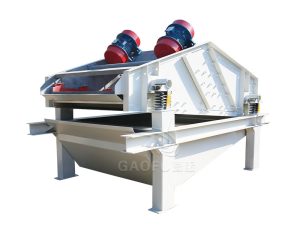
The ash and slag discharged from the gasifier slag scooper of the methanol central gasification unit has a relatively large moisture content, about 50%-60%. The slag truck also needs to be drained before leaving the factory. The road where the slag truck travels is water-damaged, which has a negative impact on the environment. pollution, and the high moisture content of the slag increases the cost of ash and slag treatment.
A slag dewatering screen was added to the discharge port of the slag scooping machine. After the modification, the moisture content of the slag was reduced to less than 20%, thereby solving the problem of continuous drainage of slag during loading and transportation, resulting in poor loading area and road environment, and at the same time reducing ash and slag Processing costs.
Gaofu slag special dewatering screen has low investment cost, low operating cost, low maintenance cost, few wearing parts, durability and low cost; continuous production, no manual operation required.
Existing problems: After the slag scooping machine pulls out the slag, the water content is relatively large. The slag truck needs to be drained when it leaves the factory.Otherwise, the following situations will occur :
1. Black water flows onto the road, polluting the environment and failing to meet environmental standards;
2. The loss of black water results in a waste of resources;
3. Black water corrodes slag trucks; ice on the road in winter poses safety risks.
Solution: After the slag dewatering screen was put into production, it achieved zero discharge of slag water and achieved energy saving, economic and social benefits.
1. Environmentally friendly and pollution-free;
2. The slag truck does not need to be drained, there is no dripping during transportation, and the road surface is clean and free of black water;
3. Water recycling and reuse;
The slag dehydration system mainly dehydrates the slag-water mixture through the dehydration screen equipment to reach the slag-water separation state. The slag is driven into the dehydration vibrating screen feed port through the slag pump or through the height difference. The dehydration vibrating screen passes the feed through two motors. It moves in a straight line from the mouth to the discharge port, and the slag on the screen is automatically discharged, and the water is discharged from under the screen.
The discharged dry slag can be sent away by a belt conveyor or transported by car. The dehydrated slag will not leak during transportation, and the water under the screen will not enter. The sedimentation tank returns water for utilization after sedimentation. Using a dewatering vibrating screen to dehydrate slag simplifies the original large slag dehydration system, reduces the area occupied by the dehydration system project, and reduces the need for operating equipment. It saves the power consumption of the factory, improves the reliability of the operation of the large slag dehydration system, reduces the production cost, and realizes zero discharge of gray water in the ash yard. The dehydrated slag is transported to the user for sale or storage in the ash yard by truck. In order to achieve the comprehensive purpose of improving the comprehensive utilization efficiency of ash and slag, saving water and electricity, extending the service life of the ash yard, and improving the environment around the ash yard.
The slag dehydration process has been successfully operated in Xinlianxin Fertilizer Plant. The dehydration vibrating screen is a solid-liquid separation equipment specially designed for slurry materials. The equipment runs in a straight line and uses gravity to automatically separate slag and water. Dewatering vibrating screen equipment has the following characteristics:
1. 24h continuous production
Can produce continuously 24 hours a day, with reliable operation, no need for manual operation, and automatic discharge of slag water.
2. Long service life
High structural strength, long service life, riveted and welded steel components, high-strength frame body
3. Compact structure
It occupies a small area, is easy to install and debug, is easy to operate and maintain, and is convenient for process layout.
4. Large processing capacity
"V" shape design of screen surface, -5° screen surface slope dehydration, low moisture content of dry materials
5. Low investment cost
Low investment cost, low operating cost, low energy consumption and few wearing parts

Dewatering screen adopt dual-electrode self-synchronization technology, universal eccentric block, adjustable amplitude vibrator. The machine is combined mainly by the screen box, exciter, support system and motor. The two mutually independent vibrators are respectively driven by the tape coupling to do synchronous reverse operation. The centrifugal force generated by two eccentric masses is superposed along the vibration direction and reversely counteracted, thereby forming a single vibration force along the vibration direction, making the screen box reciprocating linear motion.
Dewatering screen, also known as high-frequency dewatering screen, changing the water surface tension of pulp through the exciting force, pulp water through the screen to become the undersize material, and fine material is blocked by the screen to form the filter layer by the vibration of the forward movement of discharge. Dewatering screen is mainly used for detailings dewatering in the mineral processing industry, coal slurry dehydration of coal preparation plant, washed quartz sand dewatering and ceramic slurry dehydration, and wet and dry classification, dehydration, removal and mud removal of medium and fine granular materials in industrial sectors such as electric power, sugar making and salt making.